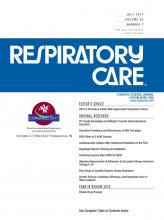Abstract
BACKGROUND: Objective measures of adherence to high-frequency chest wall compression (HFCWC), a form of airway clearance therapy for patients with cystic fibrosis, are lacking. We used a novel electronic monitoring device integrated into an HFCWC vest to measure adherence compared with self-reported adherence. We determined factors that influenced adherence and how adherence correlated with baseline pulmonary function and pulmonary exacerbations.
METHODS: Data were collected by direct measurement of date, time of day, and duration of HFCWC use to determine the number of daily treatments and daily duration of treatments. Chart review provided prescribed airway clearance therapy treatment and demographic and clinical information. Subject and caregiver report of the daily number of airway clearance therapy treatments was obtained by telephone interviews. Analysis used 2-sample and paired t test, analysis of variance, and linear regression.
RESULTS: Average adherence was 69%. Adherence was highest in children (82%, P = .02) and those receiving assistance with treatment (82%, P < .001). Subjects overestimated therapy duration from a mean ± SD of 127 ± 169% by adults to 19.2 ± 26.3% by parents or guardians of children. Average adherence decreased with increasing prescribed therapy time (P = .02). Average daily therapy time and adherence had significant positive associations with baseline FEV1 percent of predicted (P = .02 and P = .02, respectively) and negative associations with pulmonary exacerbations during the pre-study period and at baseline (P = .044 and P = .02, respectively).
CONCLUSIONS: Greater adherence to HFCWC measured directly by a novel recorder was associated with better baseline pulmonary function and fewer exacerbations in the pre-study and baseline period. Adherence decreased with age and prescribed therapy time and increased with therapy assistance. Self-report overestimation is large and thus not an accurate measure of adherence.
- adherence
- cystic fibrosis
- high-frequency chest wall compression
- pulmonary function test
- pulmonary exacerbation
Footnotes
- Correspondence: Warren E Regelmann MD, MMC 742, Pediatric Pulmonology, University of Minnesota, Minneapolis, MN 55455. E-mail: regel001{at}umn.edu.
This study was supported in part by grants from the Cystic Fibrosis Foundation and from Hill-Rom, which also provided equipment and assistance in data collection. Dr Laguna has disclosed relationships with the National Institutes of Health, the Cystic Fibrosis Foundation, the Robert Wood Johnson Foundation, the Minnesota Medical Foundation, and Cayston Pharmaceuticals. The other authors have disclosed no conflicts of interest.
Dr Mikesell presented versions of this work at the 2010 and 2011 North American Cystic Fibrosis Conferences, held October 21–23, 2010, in Baltimore, Maryland, and November 3–5, 2011, in Anaheim, California, and at the 2011 American Thoracic Society Conference, held May 13–18, 2011, in Denver, Colorado.
- Copyright © 2017 by Daedalus Enterprises











